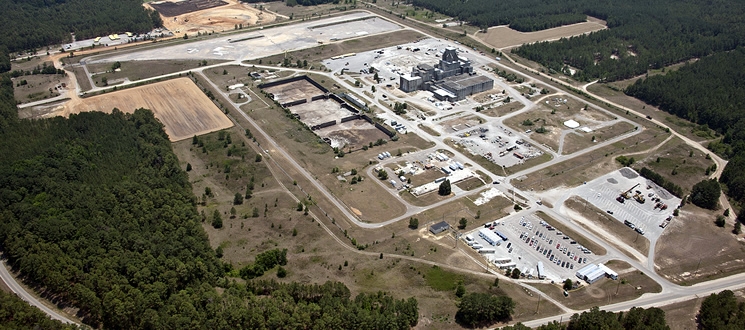SAVANNAH RIVER SITE
Photo courtesy of Energy.gov
Dashboard
-
During the 1950s, the Savannah River Site (SRS) began to produce materials used in nuclear weapons, primarily tritium and plutonium-239. Five reactors and support facilities were built to produce these nuclear materials. Irradiated materials were moved from the reactors to one of the two chemical separations plants. In these facilities, known as “canyons,” the irradiated fuel and target assemblies were chemically processed to separate useful products from waste. After refinement, nuclear materials were shipped to other DOE sites for final application.
-
Ensure SRS is a site with an enduring mission and not a closure site
Advocate for an adequate and stable SRS budget
Removal of waste from all liquid radioactive waste (HLW) tanks and closing all the tanks
Removal and offsite disposition of unwanted nuclear material and waste hazards
Continue nuclear materials stabilization and processing in the H-canyon and separations facilities
Continue support of nuclear weapons stockpile stewardship
Voice the critical need for improving the deteriorating infrastructure at SRS to ensure safe execution of Site missions
Support the construction of the Advanced Manufacturing Collaborative (AMC), an off-site innovation hub for manufacturing, fostering modern industrial practices, advancing new technologies and training the future manufacturing workforce with a focus on chemical and materials manufacturing
-
The SRS complex covers 198,344 acres, or 310 square miles, encompassing parts of Aiken, Barnwell, and Allendale counties in South Carolina, bordering the Savannah River. SRS employs approximately 11,000 people. A significant portion (approximately one third) of the SRS workforce also live in Georgia, mainly in Richmond and Columbia counties.
-
Catawba Indian Nation
-
Savannah River Site Community Reuse Organization (SRSCRO)
Mission: The mission of the SRS Community Reuse Organization is to facilitate economic development opportunities associated with Savannah River Site technology, capabilities and missions and to serve as an informed, unified community voice for the five-county, two-state SRSCRO Region.
Contact: Rick McLeod, President/CEO; Email: rick.mcleod@srscro.org
-
Savannah River Nuclear Solutions, LLC (SRNS) - SRS Management and Operations
SRNS is a partnership comprised of Fluor, Newport News Nuclear, and Honeywell.
Battelle Savannah River Alliance (BSRA) - SRNL Management and Operations
Savannah River Mission Completion, LLC (SRMC) - SRS Integrated Mission Completion Contract (SRS IMCC)
SRMC comprises parent company BWX Technologies, Inc. with partners Amentum and Fluor.
Centerra-SRS - Security Support Services
Centerra-SRS is a subsidiary of Centerra Group.
Ameresco - Biomass Cogeneration Facility
-
Federal Government
State Government
Local Government
-
Savannah River Operations Office, External Affairs
Phone: 803-952-7697
Savannah River National Laboratory
Scott Shaw
Email: scott.shaw@srnl.doe.gov
Site Budget
| FY 2022 Enacted | FY 2023 Request | FY 2023 House Bill |
|---|---|---|
| 1,592,641 | 1,571,476 | 1,595,556 |
(Defense Environmental Cleanup. Amounts in thousands of dollars. Click here for the latest site budget.)
Michael Budney
SRS Site Manager
CLEANUP ISSUES
-
Transuranic and Solid Waste Disposition
Tank Waste
Special Nuclear Materials and Spent Nuclear Fuel
Facility Deactivation and Decommissioning
Soil and Groundwater Remediation
-
In March 2022, the Office of Environmental Management released a Strategic Vision for 2022-2032.
Planned Cleanup Scope 2022–2032
Over the coming decade, DOE expects to significantly enhance its ability to tackle the largest remaining environmental risk at SRS — radioactive tank waste — with the ramp up of new waste treatment facilities. DOE will also make continued progress in addressing nuclear materials stored at SRS, and complete disposition of the remaining transuranic waste.
The full Savannah River Site Strategic Vision is available here.
NNSA Missions
-
Throughout its history, SRNL has strongly supported the national defense through its capabilities and experience in defense, homeland security, and nuclear material issues.
Since its earliest days, SRNL has developed technologies to enhance the safety and cost-effectiveness of the Savannah River Site’s work with tritium, a radioactive form of hydrogen gas that is a vital component of the nation’s nuclear defense. SRNL continues its support of a robust nuclear weapons stockpile through deployment of improved technologies and testing of components to ensure stockpile safety and reliability.
Tritium Stewardship
Non-Proliferation
Nuclear Materials Recovery
Homeland Security
Forensics/Law Enforcement
Atmospheric Technologies
-
The expertise of SRNL is a valuable resource for leading the nation to new, clean, safe, secure methods of obtaining energy sources. In particular, hydrogen, which is central to SRNL’s history, is proving to have tremendous potential for providing energy for our vehicles, homes, and industries. SRNL has expertise related to nuclear technology, materials science, geosciences, microbiology, modeling, atmospheric technologies and biotechnology, all of which contribute to helping the nation meet the crucial need for energy independence.
Nuclear Energy Projects
-
In February 2019, the U.S. Department of Energy (DOE) announced its plans to build a Versatile Test Reactor, or VTR. Once built, the research community will be able to leverage VTR’s high neutron flux to test nuclear materials 10 times faster than what is currently capable today.
VTR will:
Modernize DOE’s essential nuclear energy research and development infrastructure.
Accelerate the development of advanced nuclear fuels, materials, instrumentation, and sensors.
Reestablish the United States as a global leader in nuclear science and innovation.
Support the nation’s goal of reaching net-zero carbon emissions by 2050.
The VTR project is led by Idaho National Laboratory in partnership with five national laboratories (Argonne, Los Alamos, Oak Ridge, Pacific Northwest, and Savannah River) and includes a host of industry and university partners.
Updated August 2022.
Information in this profile is sourced from DOE, NNSA, and the site’s online resources.


